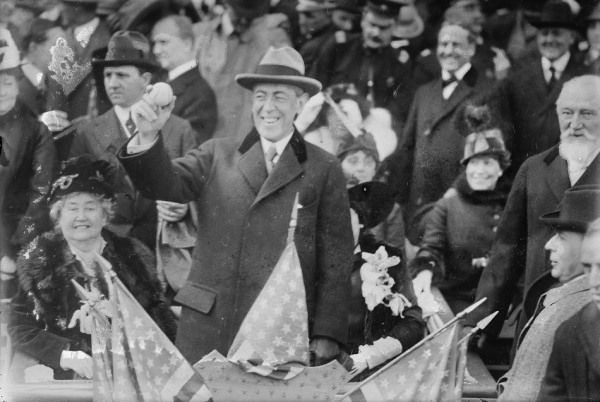By Philip Sean Curran, Staff Writer
Princeton University will remove a mural of Woodrow Wilson on campus inside a residential college named after him, the school said Wednesday in its latest attempt to reckon with legacy of the former university and U.S. president.
The image, showing Mr. Wilson throwing out the first pitch at a Washington Senators baseball game in 1915, had been in the dining hall of Wilson College since 2009, said university spokeswoman Min Pullan on Wednesday. It is due to come down over the next few days, she said. Some other type of artwork or “visual representation” will be put in its place, the school said.
The mural had become a flashpoint when the student group the Black Justice League in November staged a sit-in in Nassau Hall demanding that Mr. Wilson’s name be expunged from the residential college and the public policy school and that the mural come down, among other things. Students said Mr. Wilson had left a racist legacy at Princeton during his tenure as its 13th president, between 1902 and 1910.
In response to the protest, university President Christopher L. Eisgruber contacted the head of the college, Professor Eduardo Cadava, about starting a process “to consider” taking down the mural.
Mr. Cadava, holding a position that had been known as “master” of the college until that term was removed after the protest, formed a 12-member student committee to examine the issue. The committee recommend to Mr. Cadava that the image come down, a view that he endorsed and that the university’s Council of Heads and the Campus Art Steering Committee accepted.
“Its size and prominence in the Wilcox dining hall has seemed to us — as it has to President Eisgruber as well — ‘unduly celebratory’ and not in keeping with the spirit of Wilson College’s founding wish to have Princeton be a place that is truly diverse and inclusive and one that embraces, respects and values all its members,” Mr. Cadava wrote in a message on the Wilson College homepage.
He even disagreed with calling the image a mural, instead referring to it as a “blown-up photograph.”
“To refer to the image as a mural is to confer an artistic merit on the image that it does not really have and, because it was only installed in the dining hall seven years ago and mostly as a signature design element, it also does not have the longstanding value that other honorific memorials might have,” Mr. Cadava wrote.
He also touched on the history of Wilson College, which traces its roots to a group of undergraduates attending Princeton in the 1950s who opposed the selective process of choosing members at the student eating clubs. What began as Wilson Lodge today is home to about 500 students.
“The College history deserves to be recalled and preserved, not simply in our memory but also in our ongoing efforts to create a sense of community that is inclusive rather than exclusionary, that is respectful of difference rather than neglectful of it,” he wrote.
The decision comes after the university rejected some of the protestors’ other demands. University trustees announced earlier this month the college and Woodrow Wilson School of Public and International Affairs would keep their names.

